Plaister Meaning in the Bible: Healing and Symbolism
In biblical texts, ‘plaister‘ refers to a material used for coating walls, symbolizing repair, protection, and divine intervention. Rooted in ancient construction and healing practices, it underscores themes of spiritual renewal and God’s capacity to mend brokenness.
Passages such as Ezekiel 13:10-15 and Leviticus 14:42-43 use plaister metaphorically to convey ideas of moral and spiritual restoration. The substance’s use in fortified structures and purifying homes emphasizes its symbolic role in representing care, compassion, and the transformative power of divinity.
This utilization enriches our understanding of healing and integrity within scripture, beckoning a deeper exploration into its theological significance.

Key Takeaways
- Symbolizes spiritual healing and restoration, reflecting God’s ability to mend brokenness.
- Represents divine intervention and forgiveness, metaphorically covering imperfections and transgressions.
- Used in biblical narratives to signify moral and spiritual renewal.
- Highlights themes of compassion and care extended by God or individuals.
Definition of Plaister
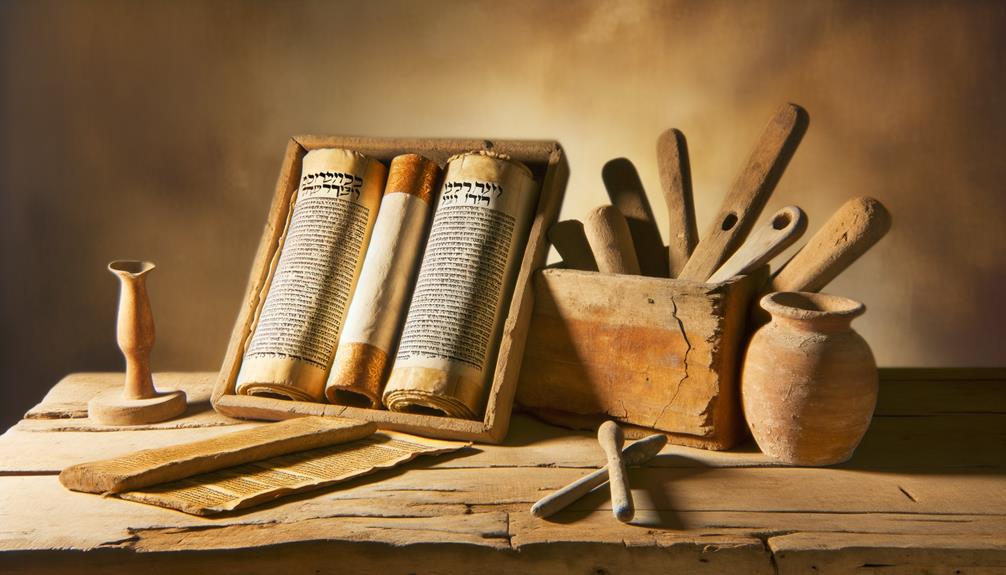
Derived from the Old English and Middle English terms, ‘plaister’ in the biblical context refers to a material used for coating walls, often signifying themes of repair, protection, and concealment in scriptural narratives.
Its primary function is to cover imperfections and fortify structures, symbolizing the act of restoring and safeguarding what is broken or vulnerable.
The concept extends metaphorically to the spiritual and moral domains, where ‘plaistering’ may represent divine intervention, forgiveness, or the concealment of sins.
In the Bible, this term is not merely a physical descriptor but a profound symbol of healing and redemption, encapsulating the dual roles of physical repair and spiritual renewal.
Understanding ‘plaister’ consequently requires appreciating its layered implications within biblical literature.
Historical Context
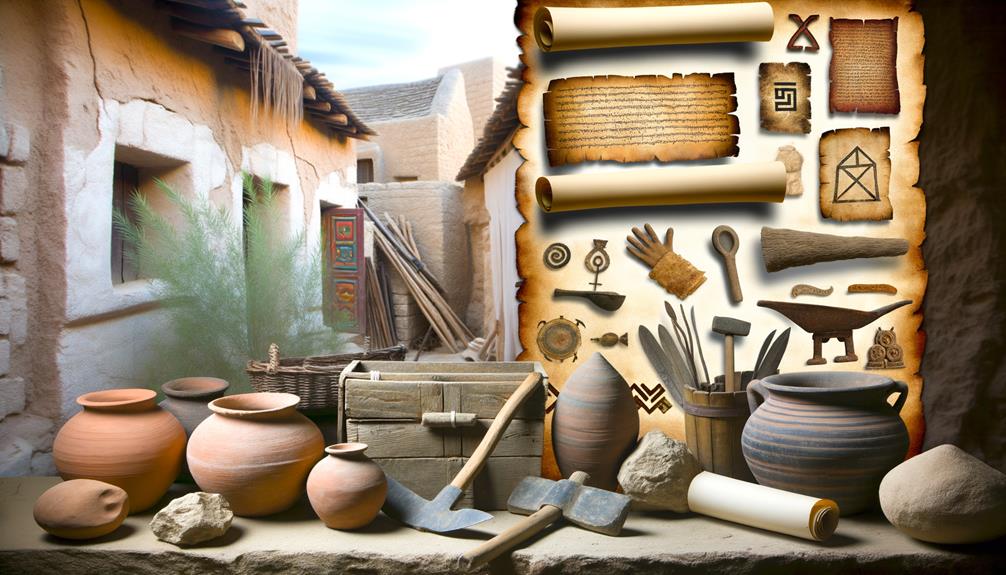
The historical context of ‘plaister’ in biblical texts is rooted in ancient construction practices and cultural beliefs, which imbue the term with significant architectural and theological connotations.
In antiquity, plaister, or plaster, was a fundamental material used to coat walls and structures, often made from lime, sand, and water. This practice not only served practical purposes for fortification and insulation but also conveyed symbolic meanings, such as purity and protection.
The application of plaister was a meticulous task, reflecting the society’s emphasis on strong, enduring structures. Consequently, the term ‘plaister’ carries deeper implications within biblical narratives, highlighting the intersection of physical construction and spiritual edification, reflective of the broader cultural and religious milieu of the time.
Biblical References

In examining the term ‘plaister‘ within the Bible, it is evident that its use extends beyond mere construction, embedding itself in scriptural passages that underscore themes of restoration, integrity, and divine intervention.
For instance, in Ezekiel 13:10-15, ‘plaister’ symbolizes false assurances given by prophets, a metaphor for superficial fixes to deeper issues.
Similarly, in Leviticus 14:42-43, ‘plaister’ illustrates the process of purifying a house afflicted by mold, emphasizing cleansing and renewal.
These references highlight ‘plaister’ as more than a material; it serves as a theological metaphor for addressing moral and spiritual decay.
Through these contexts, the term enriches our understanding of Biblical narratives concerning healing and authenticity, reflecting the divine imperative for genuine restoration.
Cultural Significance
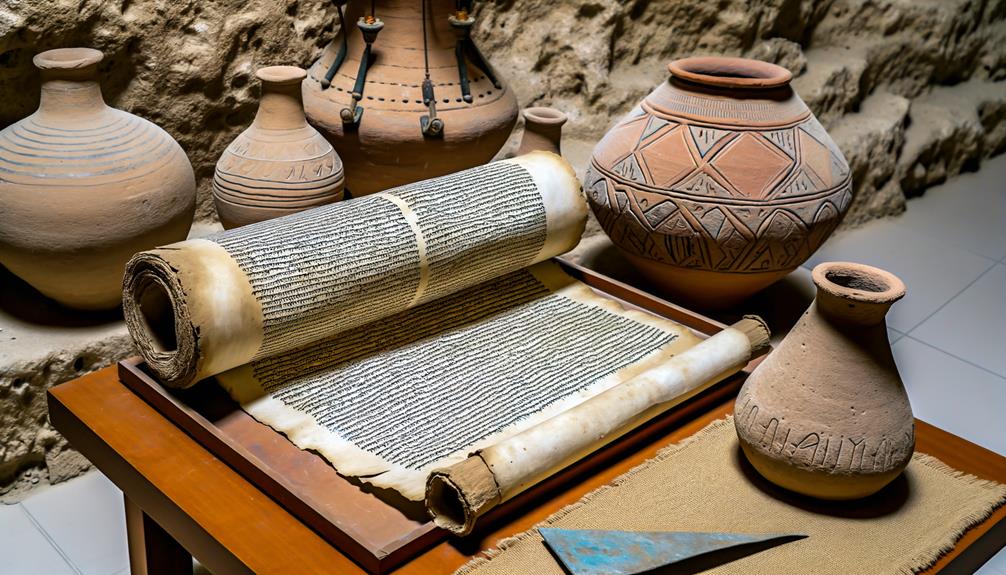
The cultural significance of ‘plaister’ in the Bible encompasses both ancient healing practices and symbolic interpretations.
Historically, plaisters were employed in medicinal contexts to treat wounds and ailments, reflecting the practical aspects of health care in biblical times.
Symbolically, plaisters can be seen as metaphors for spiritual healing and restoration, illustrating deeper theological themes within the scriptural narrative.
Ancient Healing Practices
Frequently regarded as a cornerstone of ancient medical practices, the use of plaister in biblical times reflects a profound understanding of natural remedies and their cultural significance in promoting healing and wellness. The application of plaister, a mixture of herbs and other natural substances, served various therapeutic purposes. This practice was deeply embedded in the medicinal traditions of the time, showcasing an early form of integrative health care.
To illustrate, consider the following:
- Herbs and Plants: Ingredients like myrrh and frankincense were common, prized for their antiseptic properties.
- Cultural Rituals: The preparation and application often involved specific rituals, underscoring its cultural importance.
- Holistic Approach: Treatments addressed not just the physical ailment but also spiritual well-being.
- Community Knowledge: Wisdom regarding plaister was often shared communally, reflecting the collective effort in health maintenance.
Symbolic Interpretations
Many scholars assert that the symbolic interpretations of plaister in the Bible go beyond mere physical healing, embodying broader themes of restoration, faith, and divine intervention.
In scriptural contexts, plaister is often depicted as a metaphor for spiritual renewal and God’s ability to mend the brokenness within human lives.
For instance, the act of applying plaister can be seen as an expression of faith, trusting in God’s power to heal both body and soul.
Additionally, plaister serves as a cultural signifier of communal care, highlighting the importance of mutual support and collective faith in divine providence.
Consequently, the use of plaister in biblical narratives encapsulates a profound interplay between physical remedies and spiritual symbolism, enriching the cultural and theological tapestry of the text.
Craftsmanship Techniques
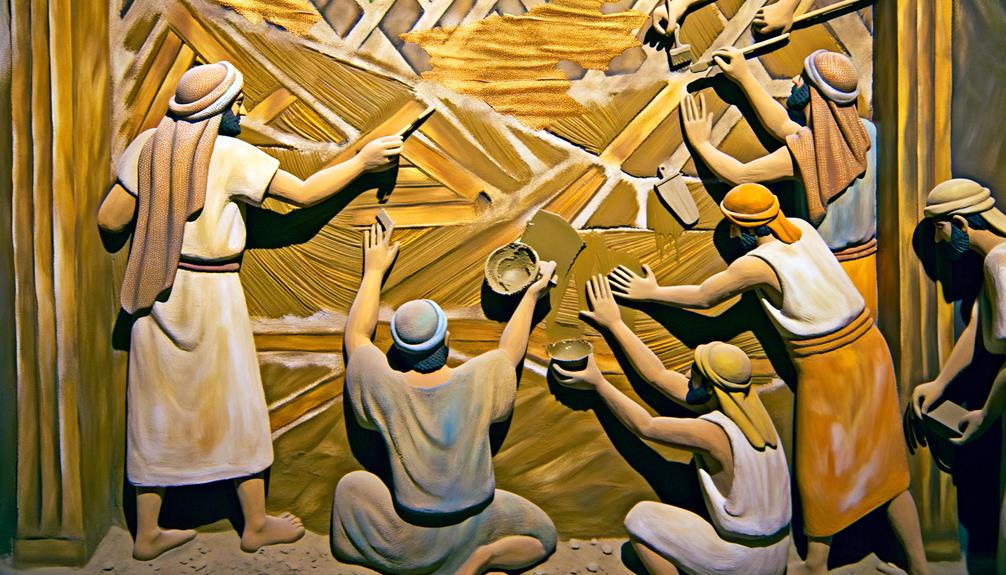
Intricate craftsmanship techniques in the biblical era were pivotal in the creation of religious artifacts and structures, often reflecting profound theological and cultural significance.
The artisans of that time employed various sophisticated methods to achieve their stunning works, which have been documented in biblical texts and archaeological findings.
Some notable techniques include:
- Stone Carving: Used extensively in temple construction, including detailed reliefs and inscriptions.
- Metalworking: Employed in the crafting of sacred objects such as the Ark of the Covenant and temple implements.
- Woodworking: Essential for creating structural elements and intricate decorations in sacred spaces.
- Mosaic and Inlay Work: Utilized to add intricate designs and symbolic imagery to floors, walls, and religious artifacts.
These techniques highlight the immense skill and dedication of craftsmen in biblical times.
Symbolic Meanings

The use of plaister in the Bible is imbued with profound symbolic meanings, particularly in the contexts of healing and restoration, as well as spiritual renewal.
In various biblical passages, plaister is not merely a physical material but serves as a metaphor for God’s ability to mend and rejuvenate the broken and wounded.
This dual symbolism underscores its significance in illustrating the transformative power of divine intervention and spiritual rebirth.
Healing and Restoration Symbolism
In biblical texts, the term ‘plaister’ often carries profound connotations of healing and restoration, symbolizing not only physical mending but also spiritual renewal and divine intervention. This term encapsulates multifaceted layers of meaning that reflect its significance in ancient scriptural contexts.
Physical Healing: Plaister is frequently used to describe substances applied to wounds, emphasizing its role in physical recovery and health.
Divine Intervention: The application of plaister can represent God’s direct involvement in the healing process.
Symbol of Care: It serves as a metaphor for the compassion and care extended by God or individuals toward the suffering.
Restoration of Wholeness: Plaister symbolizes the restoration of completeness, whether in a person’s body or in the community’s spiritual state.
Spiritual Renewal Symbolism
Building upon the multifaceted layers of healing and restoration, plaister also embodies profound symbolism in the context of spiritual renewal within biblical narratives.
Often used metaphorically, plaister signifies the mending of the soul, the covering of transgressions, and the renewal of one’s covenant with God.
Just as plaister physically repairs walls, it spiritually represents God’s grace in repairing the fractured human spirit. This analogy is rooted in passages where God promises to heal a broken people, binding their wounds and restoring their faith.
Consequently, plaister becomes more than a mere material; it is an emblem of divine intervention, illustrating the hope and potential for spiritual transformation and revival.
This symbolic renewal underscores a deeper theological narrative of redemption.
Comparison With Modern Plaster
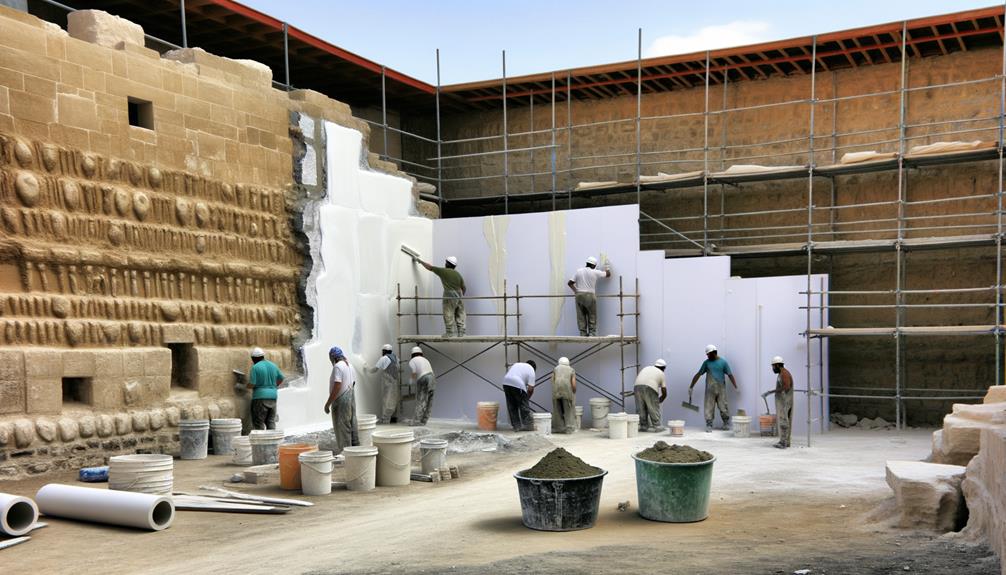
While ancient plans for creating plaster, or ‘plaister’ as referenced in biblical texts, relied heavily on naturally occurring materials like lime and gypsum, modern plaster compositions have evolved to incorporate synthetic additives and advanced manufacturing techniques. This evolution reflects the advancements in both technology and material science, offering enhanced properties and broader applications.
Key differences between ancient and modern plaster include:
- Composition: Ancient plaster primarily used lime and gypsum, while modern plaster often includes polymers and other synthetic materials.
- Durability: Modern plaster formulations provide increased durability and resistance to environmental factors.
- Flexibility: Contemporary plasters can be engineered for specific uses, such as fire resistance or acoustic properties.
- Application: Advanced tools and methods allow for more efficient and uniform application in modern construction.
Archaeological Findings
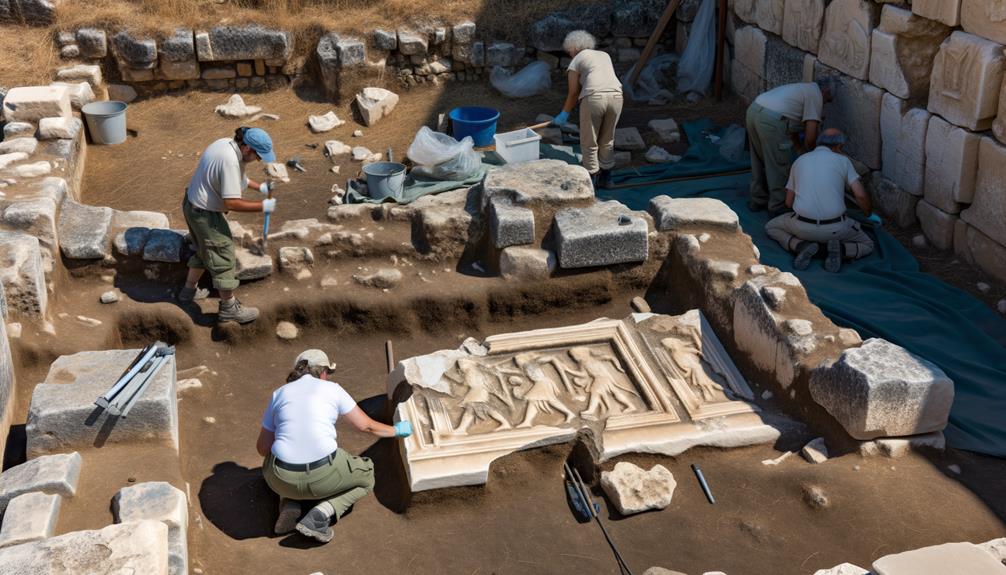
Archaeological excavations have unearthed numerous examples of ancient plasterwork, providing invaluable insights into its composition, application methods, and cultural significance in historical contexts.
Significantly, findings from sites such as Jericho and Qumran reveal the use of lime-based plaster mixed with fine aggregates. These plasters were applied to walls and floors, showcasing advanced craftsmanship and an understanding of durable construction techniques.
Decorative elements, including frescoes and inscriptions, have also been preserved, indicating that plaster served both functional and aesthetic purposes. The presence of plaster in religious and domestic settings underscores its pervasive role in daily life and spiritual practices.
These discoveries offer a glimpse into the technological and cultural fabric of ancient civilizations, enriching our comprehension of historical biblical references to plaster.
Lessons for Today

The archaeological findings of ancient plasterwork not only deepen our understanding of historical contexts but also offer valuable lessons for contemporary construction and cultural preservation practices.
Modern architects and conservators can draw insights from these ancient techniques to enhance the durability and sustainability of present-day structures.
Here are four key takeaways:
- Sustainable Materials: Ancient plaster, often composed of lime and sand, underscores the benefits of using eco-friendly and locally sourced materials.
- Craftsmanship: The meticulous application techniques highlight the importance of skilled labor and craftsmanship in construction.
- Cultural Significance: Plasterwork often carried symbolic meanings, emphasizing the need to preserve cultural heritage in modern designs.
- Durability: The longevity of ancient plaster indicates the effectiveness of traditional methods, advocating for their integration into contemporary practices.
Conclusion
In sum, the term ‘plaister’ in the Bible encapsulates a complex blend of historical, cultural, and symbolic significances.
Significantly, archaeological findings reveal that plaister was a prevalent material, with ancient structures exhibiting plasterwork that has endured for millennia. This underscores its durability and importance in historical craftsmanship.
For instance, studies indicate that some biblical-era plastered walls have survived over 3,000 years, reflecting both the material’s longevity and the advanced techniques employed by ancient artisans.






